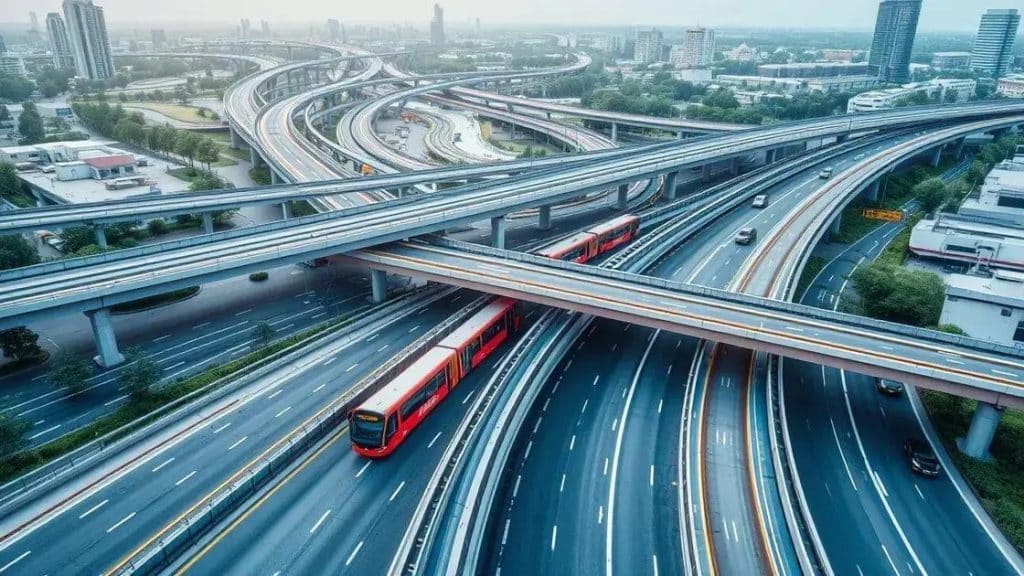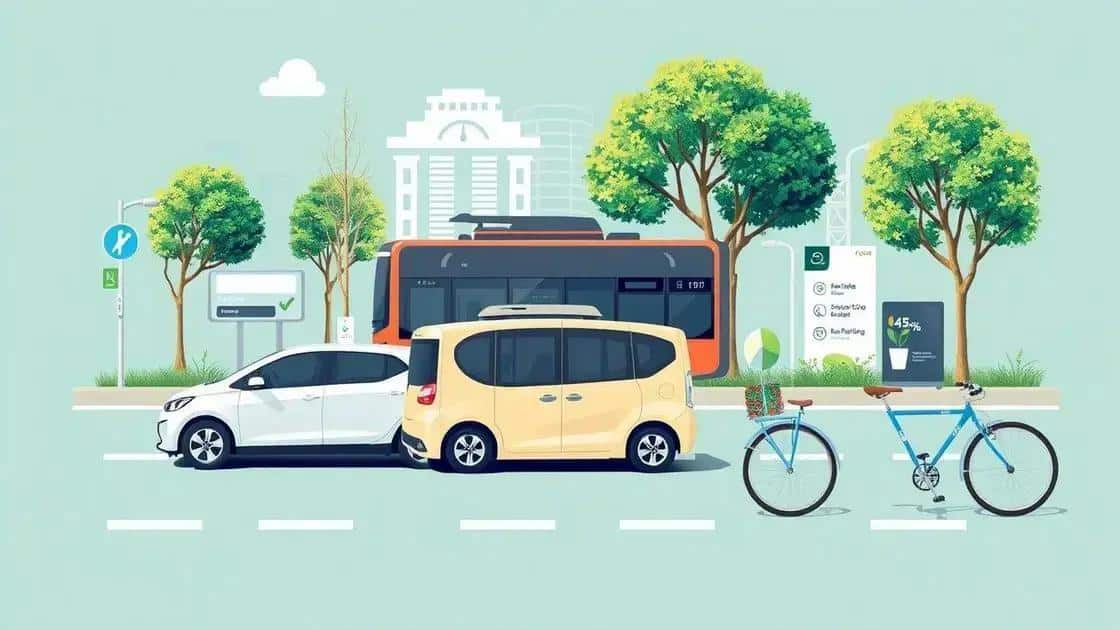Instead transport infrastructure news: what’s changing now?

The future of transport infrastructure focuses on smart cities, green initiatives, and autonomous vehicles, aiming for enhanced efficiency, sustainability, and safety in transportation systems.
Instead transport infrastructure news is shaping the way we travel and connect. How are recent changes affecting your daily commute? Let’s dive into the latest updates.
Key advancements in transport infrastructure
The landscape of transport infrastructure is evolving rapidly. Key advancements are shaping how we move from one place to another, improving safety and efficiency.
Smart Transportation Systems
One major advancement is the development of smart transportation systems. These systems use technology to enhance travel experiences. Features include:
- Traffic management using real-time data.
- Public transit apps providing schedule updates.
- Connected vehicles that communicate with infrastructure.
Such innovations lead to less congestion and better travel times.
Green Initiatives
Moreover, there is a growing emphasis on sustainability. Green initiatives focus on reducing the environmental impact of transportation. This includes:
- Electric buses and vehicles gaining popularity.
- Increased investment in bike lanes.
- Integration of renewable energy sources in public transit.
These efforts not only cut emissions but also promote healthier lifestyles.
Investments in infrastructure are also moving towards resilience. As climate change poses threats, cities are preparing their transport systems. For instance, building flood-resistant roads and bridges helps maintain connectivity during adverse weather.
In addition, digital technologies play a crucial role. Enhanced data collection and analysis lead to informed decision-making. Cities now rely on big data to understand traffic patterns, improving planning and infrastructure development.
Furthermore, autonomous vehicles are on the rise, promising to transform mobility. They have the potential to reduce accidents, improve traffic flow, and ensure accessibility for all.
Overall, these advancements in transport infrastructure collectively aim to create safer, greener, and more efficient systems for the future.
Impact of technology on transportation
The impact of technology on transportation is significant and multifaceted. It reshapes how we travel, making journeys quicker and safer.
Connected Vehicles
One prominent innovation includes connected vehicles. These cars, trucks, and buses communicate with each other and transportation systems. This technology improves:
- Traffic flow and reduces congestion.
- Overall safety through collision prevention features.
- Driver awareness with real-time information.
This integration allows for smoother travel experiences.
Autonomous Driving
Another breakthrough is the rise of autonomous driving. Self-driving vehicles have the potential to transform our daily commutes. Benefits of autonomous technology include:
- Reducing human error, which is a major cause of accidents.
- Increased mobility for those unable to drive.
- Enhanced efficiency in transportation networks.
This shift toward autonomous driving promises safer and more efficient roads for everyone.
Additionally, mobile apps are playing a crucial role. They provide access to ride-sharing and on-demand transportation services. With just a few taps, users can find convenient rides, improving accessibility.
Furthermore, advanced logistics and delivery systems are changing how goods are transported. Technologies like drones and automated delivery vehicles are on the rise, ensuring quicker and more efficient shipping solutions.
Another key area is the use of data analytics. Cities analyze traffic patterns and transportation data to make informed decisions. This improves infrastructure planning and public transport services, leading to better experiences for commuters.
As technology progresses, the overall landscape of transportation will continue to evolve, presenting new opportunities and challenges for everyone.
Sustainability trends in transport development

Sustainability trends in transport development are gaining momentum worldwide. As the focus on environmental preservation grows, cities are adopting practices that minimize ecological footprints.
Electric Vehicles
One prominent trend is the increase in electric vehicles (EVs). These cars produce zero tailpipe emissions, making them a cleaner option. More cities are investing in:
- Charging stations to support EV use.
- Incentives for consumers to purchase electric cars.
- Fleet conversions to electric buses and trucks.
This shift not only benefits the environment but also promotes energy independence.
Public Transport Innovations
Another key development involves enhancing public transport systems. Sustainable choices here include:
- Upgraded electric trains and trams for cleaner commuting.
- Expansion of bike-sharing programs for short-distance travel.
- Development of pedestrian-friendly infrastructure.
These improvements encourage more people to opt for public transport over personal vehicles.
Additionally, many cities are integrating smart technology into transportation. This includes using data analysis to optimize routes and reduce energy consumption. By analyzing traffic patterns, cities can promote smoother flows, which leads to lower emissions.
Another important trend is urban planning that prioritizes sustainability. Creating mixed-use developments reduces the need for long commutes and promotes walking and biking. This thoughtful approach fosters healthier communities and decreases vehicle dependency.
As these trends continue to evolve, they will significantly impact how we think about mobility. Emphasizing sustainability in transport will lead to cleaner air, healthier people, and improved quality of life.
Government policies affecting transport systems
Government policies play a crucial role in shaping transport systems. These regulations and incentives influence how infrastructure develops and how services operate.
Funding Initiatives
One major area of focus is funding initiatives. Governments often allocate budgets to improve transport infrastructure. Key aspects include:
- Grants for public transit upgrades.
- Investment in new roads and bridges.
- Support for sustainable transport projects.
These initiatives help ensure that transport systems can meet the demands of growing populations.
Environmental Regulations
Another important factor is environmental regulations. Governments are implementing stricter rules to promote sustainability. This leads to:
- Encouragement of electric and hybrid vehicles.
- Incentives for transit-oriented development.
- Restrictions on emissions from public transport.
Such measures aim to reduce the carbon footprint of transport systems.
Furthermore, policies related to safety are essential. Governments enforce laws and guidelines to protect users on the roads. Examples include lowering speed limits, enhancing pedestrian crossings, and promoting seat belt use.
Another aspect is the promotion of equity in transport access. Policies focus on ensuring all communities have access to reliable transport options. This includes planning public transport routes that serve underserved areas, improving accessibility for people with disabilities, and providing affordable fare options.
As these government policies evolve, they will continue to shape the future of our transport systems, fostering improvements in safety, sustainability, and accessibility.
Future predictions for transport infrastructure
Future predictions for transport infrastructure indicate significant changes ahead. Experts foresee advancements that will reshape how we move and connect.
Smart Cities
One major prediction focuses on the rise of smart cities. These urban areas will integrate technology into their transport systems. Benefits include:
- Improved traffic management through real-time data.
- Seamless public transport connections.
- Enhanced safety features in vehicles and infrastructure.
As cities become smarter, commuting will become more efficient and less stressful.
Green Transportation Initiatives
In addition, there’s a growing emphasis on green transportation initiatives. The shift towards sustainability will lead to:
- Increased use of electric and hybrid vehicles.
- Expanded bike lanes and pedestrian paths.
- Investment in renewable energy sources for public transport.
These initiatives will reduce emissions and promote healthier lifestyles.
Moreover, autonomous vehicles are expected to play a larger role in the future. Self-driving technology will revolutionize how we travel. This will likely result in:
- Fewer accidents due to reduced human error.
- Greater accessibility for individuals with disabilities.
- More efficient use of road space, reducing congestion.
As autonomous vehicles integrate into society, traffic patterns may shift dramatically.
Lastly, collaborative urban planning will lead to more effective transport solutions. Communities will work together to create transport networks that serve everyone. This will enhance access to public transport, reduce commuting times, and promote sustainable practices.
In conclusion, the future of transport infrastructure is filled with exciting possibilities. Advancements in technology and sustainability are set to transform our travel experiences. As cities embrace smart technologies, enhance public transport, and prioritize greener initiatives, we can look forward to safer, more efficient, and environmentally friendly transportation systems. With ongoing collaboration between governments, technologies, and communities, the way we move will evolve to meet the needs of future generations.
FAQ – Frequently Asked Questions about Transport Infrastructure
What are smart cities?
Smart cities use technology to improve transportation efficiency, reduce traffic, and enhance public services for residents.
How do green initiatives impact transportation?
Green initiatives promote the use of electric vehicles and public transport to reduce emissions and promote sustainable travel options.
What role do government policies play in transport systems?
Government policies provide funding, establish safety regulations, and support sustainable transportation, all of which shape infrastructure development.
What is the future of autonomous vehicles?
The future of autonomous vehicles is promising, with expectations of safer roads, increased accessibility, and reduced traffic congestion.





